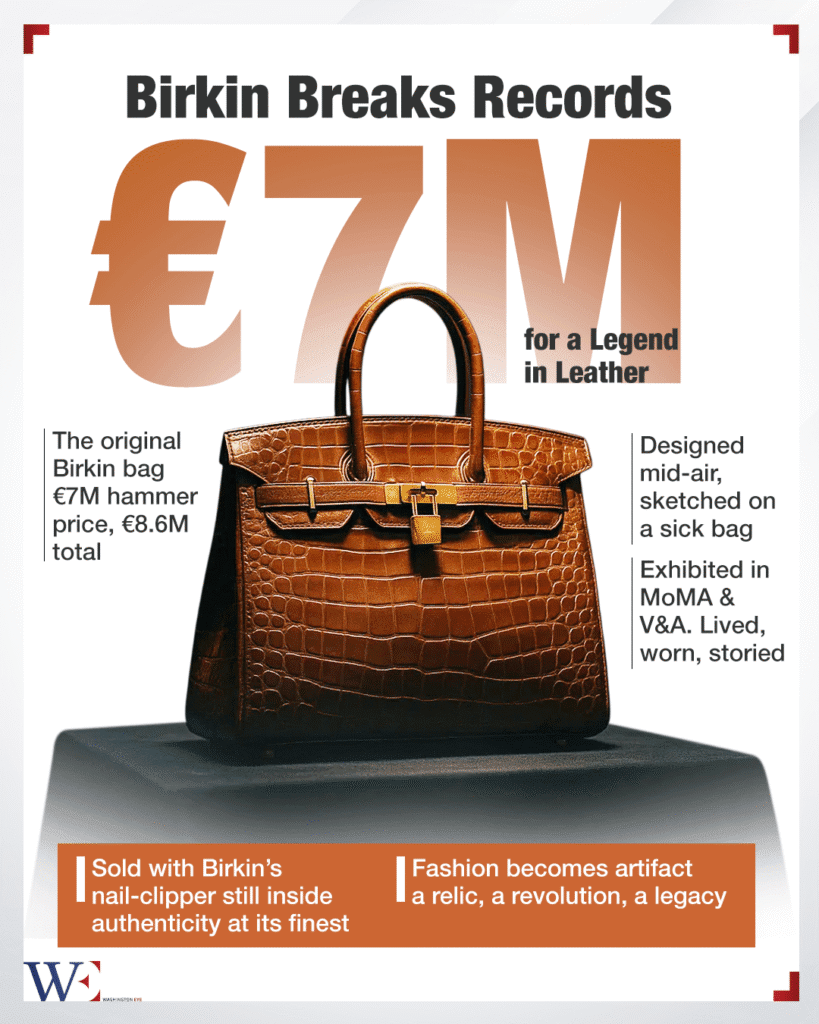In a historic moment for both fashion and auction history, Jane Birkin’s original Hermès Birkin bag—the very first of its kind—was sold for a staggering €7 million on July 10, 2025, at Sotheby’s Paris, marking it as the most expensive handbag ever sold. The total sale price, including fees, reached €8.6 million (approximately \$10 million), shattering all previous records for luxury accessories and highlighting the bag’s legendary status in fashion lore.
This particular bag, designed in 1984, was not a commercial model but a unique prototype crafted specifically for Jane Birkin. Its origin dates back to a now-iconic flight from Paris to London in 1983, during which Birkin met Jean-Louis Dumas, then CEO of Hermès. Birkin lamented the lack of practical handbags, prompting Dumas to sketch a design on an airline sick bag—thus, the Birkin bag was born. Made of black supple leather with gilded brass hardware, this one-of-a-kind piece featured a shoulder strap (later removed from standard models), brass studs, and Birkin’s initials “J.B.” embossed beneath the lock. Adding even more character, her nail-clipper remained attached to the interior zipper—an intimate, quirky touch that captivated collectors and fashion historians alike.
Unlike the pristine, showroom-fresh Birkins that dominate today’s luxury scene, this prototype bore heavy signs of use. Birkin carried it religiously for nearly a decade before donating it in 1994 to support AIDS-related charities. It was later purchased in 2000 by French collector Catherine Bernier, who kept it for 25 years. During her ownership, the bag was exhibited in major museums, including MoMA in New York and the Victoria and Albert Museum in London, adding further cultural weight to its legacy.
At the Sotheby’s auction, held during Paris Haute Couture Week, the bag attracted frenzied attention. Bidding opened at €1 million and escalated rapidly in a fierce ten-minute battle involving multiple bidders from across the globe. The final, victorious offer came from an anonymous private collector in Japan, bidding by phone. While Sotheby’s did not officially reveal the buyer’s identity, some reports pointed toward Valuence Japan, a high-end luxury resale firm known for acquiring historical fashion artifacts.
The sale is significant not just for the jaw-dropping price, but for what it represents in the world of fashion and collectibles. It’s a reflection of how fashion, especially pieces with rich cultural provenance, is increasingly being valued as investment-grade art. This Birkin isn’t just a handbag—it’s a relic of celebrity, craftsmanship, and style innovation. In the words of one fashion historian, it is “the Mona Lisa of handbags.”
The Birkin bag has long symbolized luxury, power, and exclusivity. But this particular bag’s humble yet glamorous history makes it uniquely powerful. It began with a spontaneous conversation and a simple sketch, evolved into a fashion revolution, and has now been immortalized through a record-breaking sale. For some, the irony lies in the bag’s worn appearance—scratched leather, stained interiors, and all. But for collectors and fashion connoisseurs, it is precisely this well-worn authenticity and direct connection to Jane Birkin herself that makes it priceless.
This auction also comes at a time when the role of luxury in fashion is being re-evaluated. While brands like Hermès continue to represent elite craftsmanship, new generations are also embracing accessibility and diversity in design. Still, the cultural and historical weight of this particular Birkin bag is indisputable. It’s not just a handbag—it’s a story, an icon, and now, the most valuable accessory ever sold in Europe.
In the end, Jane Birkin’s original Hermès bag—scuffed, storied, and full of personal flair—did more than break records. It told a tale of how fashion intersects with identity, history, and art. With its sale, it enters a new chapter, no longer just a handbag, but a legend in leather.
















